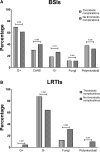High Risk of Secondary Infections Following Thrombotic Complications in Patients With COVID-19
- PMID: 36168552
- PMCID: PMC9511118
- DOI: 10.1093/ofid/ofac454
High Risk of Secondary Infections Following Thrombotic Complications in Patients With COVID-19
Abstract
Background: This study's primary aim was to evaluate the impact of thrombotic complications on the development of secondary infections. The secondary aim was to compare the etiology of secondary infections in patients with and without thrombotic complications.
Methods: This was a cohort study (NCT04318366) of coronavirus disease 2019 (COVID-19) patients hospitalized at IRCCS San Raffaele Hospital between February 25 and June 30, 2020. Incidence rates (IRs) were calculated by univariable Poisson regression as the number of cases per 1000 person-days of follow-up (PDFU) with 95% confidence intervals. The cumulative incidence functions of secondary infections according to thrombotic complications were compared with Gray's method accounting for competing risk of death. A multivariable Fine-Gray model was applied to assess factors associated with risk of secondary infections.
Results: Overall, 109/904 patients had 176 secondary infections (IR, 10.0; 95% CI, 8.8-11.5; per 1000-PDFU). The IRs of secondary infections among patients with or without thrombotic complications were 15.0 (95% CI, 10.7-21.0) and 9.3 (95% CI, 7.9-11.0) per 1000-PDFU, respectively (P = .017). At multivariable analysis, thrombotic complications were associated with the development of secondary infections (subdistribution hazard ratio, 1.788; 95% CI, 1.018-3.140; P = .043). The etiology of secondary infections was similar in patients with and without thrombotic complications.
Conclusions: In patients with COVID-19, thrombotic complications were associated with a high risk of secondary infections.
Keywords: bacteria; coronavirus; infections; pulmonary embolism; thrombosis.
© The Author(s) 2022. Published by Oxford University Press on behalf of Infectious Diseases Society of America.
Conflict of interest statement
Potential conflicts of interest. A.C. has received consultancy payments and speaking fees from Bristol-Myers Squibb, Gilead, ViiV Healthcare, Merck Sharp & Dohme, and Janssen-Cilag. All other authors declare that they have no conflicts of interest. All authors have submitted the ICMJE Form for Disclosure of Potential Conflicts of Interest. Conflicts that the editors consider relevant to the content of the manuscript have been disclosed.
Figures



